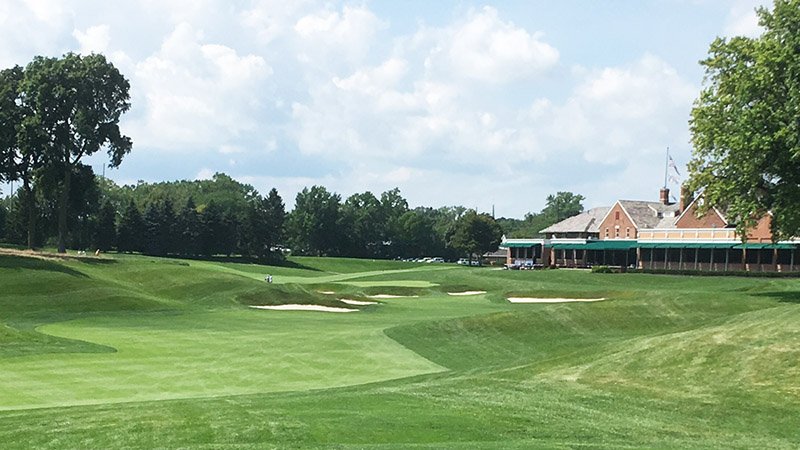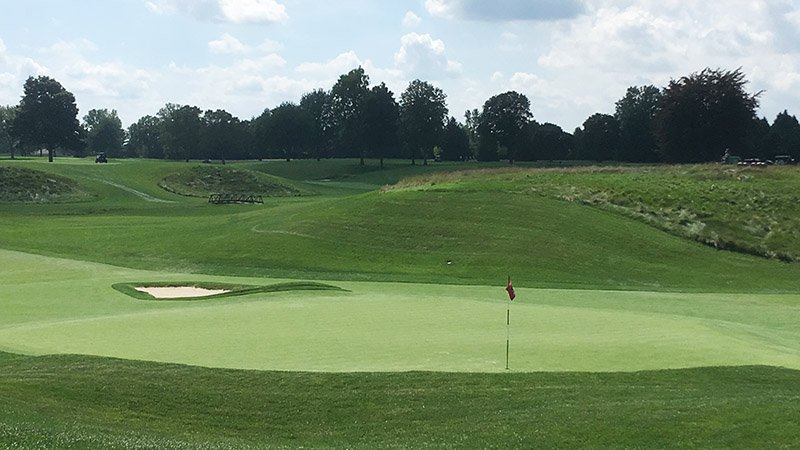Some things are so obvious they defy discussion: Coke beats Pepsi, bacon makes everything better and Toledo, Ohio, is the perfect location for the Solheim Cup.
Home to one of the LPGA's longest-running events, the Toledo area has a history of promoting women's golf that few other locations can match. That commitment to furthering the game among women will be on display for all to see Aug. 31-Sept. 6 when historic Inverness Club plays host to the Solheim Cup.
The connection to women's golf in the Toledo area is so strong, it is kind of a surprise that it has taken the LPGA so long to bring its premier event here.
With a fresh coat of paint thanks to a 2018 restoration by architect Andrew Green and a bold and aggressive membership that went and plucked superintendent John Zimmers away from storied Oakmont where he had successfully navigated through two U.S. Open championships, Inverness is ready to show its stuff. And so is Toledo.
"John and his team have provided a canvas for the Solheim Cup that is second to none," Green said. "The tireless efforts of the team at Inverness have allowed the design elements to shine through."
The Solheim Cup is a big deal here. More than 100,000 advance tickets have been sold, including about 60,000 to patrons from outside Ohio, and a new highway interchange completed just a month ago has made access to the club from Interstate 475 and U.S. 23, which previously required extensive local knowledge, a breeze.
"The support for the Marathon Classic all the way back to the Jamie Far has made Toledo an appealing site," said Carlton Henry, an assistant superintendent at Inverness who came with Zimmers from Oakmont. "The LPGA knew this was a market that supports women's golf. They know people are going to buy tickets and support the event."
The membership who hired Green and Zimmers and bought in to a reinvention of their golf course are ready to show off the 1916 Donald Ross design.
"I play golf with people who have played this course for 50 years, and they all say it has never looked this good," said Mike McCullough, the club's historian. "We are spoiled at just how good it is. Many of our members are members at national clubs, and they tell me they have never experienced anything like the conditions we have here."

Like so many northern cities going through post-industrial decline, Toledo has had a hard time of it in recent years. The city lost about 20 percent of its population over a 30-year span beginning in 1980. Some moved to the suburbs, others moved away altogether. As a result, Toledo has been a regular visitor to the FBI's list of the country's most dangerous cities. For all its warts and blemishes, Toledo's role of promoting women's golf fits the city like a glove.
"It is not a stretch to say this is easily the most important moment in Inverness Club history in the past 30 years," McCullough said. "From the announcement of the club getting the Solheim Cup, then bringing in Andrew Green for the most significant renovation since 1977 that turned out better than anyone expected, this is going to showcase really well, not just for Inverness, but also for Toledo which has a history of supporting women's golf.
"They even built a new exit off 475 and 23 that now dumps off on Dorr Street a mile from the club. A lot of work has taken place to end up where we are right now."
John and his team have provided a canvas for the Solheim Cup that is second to none. The tireless efforts of the team at Inverness have allowed the design elements to shine through.
Inverness has a rich tradition of championship golf. Designed by Donald Ross from 1916-1918, Inverness has been the host of four U.S. Open Championships (1920, '31, '57, '79), a pair of PGA Championships (1986, '93), two U.S. Senior Open Championships (2003, '11), the 1973 U.S. Amateur and most recently the 2019 U.S. Junior Amateur.
What has evolved into the USGA Green Section was founded there more than a century ago.
The club also has answered the call for promoting women's golf, which has a rich history in northwestern Ohio.
The LPGA's Marathon Classic, played a few miles up 475 at Highland Meadows Golf Club in Sylvania, is the second-oldest continuous event on the women's tour. Affiliated with Jamie Farr of MASH fame from its inception through 2012, the tournament originated at Glengarry Country Club (now Stone Oak CC) in nearby Holland in 1984. The tournament, which has gone through a host of name changes, moved to Highland Meadows in 1989 and has been played there ever since.
Only the Cambia Portland Classic, which has been played since 1972, is older. The Marathon Classic moved up two spots from No. 4 to No. 2 when the CP Women's Classic and the Toto Japan Classic, both founded in 1973, were canceled in 2020 due to Covid.
As the LPGA scrambled last year with cancellations and other challenges associated with the pandemic, it found a solution in Toledo.

When the LPGA needed a second event in the Toledo area last year to bookend with the Marathon Classic and help limit player travel during the pandemic, the association asked the membership at Inverness about the chances of Zimmers and his team getting the place tournament ready on short notice. With five weeks to get ready, Inverness wowed LPGA players during the Drive On Championship.
"Like, even the way they cut the grass here, it gives you such a major championship feel when you're out there," LPGA player Nelly Korda said during last year's Drive On Championship. "It's super nice."
Providing championship conditions on a daily basis is page 1 out of the Zimmers playbook, said Ryan Kaczor, an assistant superintendent at Inverness.
"The feedback from the players was all very positive," Kaczor said. "We can have a championship course ready for an event like that at a moment's notice. The golf course was a good test for them, and it gave them an opportunity to become familiar with the course moving into the Solheim Cup this year."
Danielle Kang was dutifully impressed, as well. Kang, who won the Drive On and followed up with a win at Highland Meadows the following week, bequeathed her putter to Zimmers, who offered her some advice on how to handle green speeds at Inverness.
We can have a championship course ready for an event like that at a moment's notice. The golf course was a good test for them, and it gave them an opportunity to become familiar with the course moving into the Solheim Cup this year.
The LPGA's first foray into the Toledo area came years before the Marathon Classic. With interest in women's golf waning, the LPGA wanted to drum up enthusiasm by hosting a pro-am event at a yet-to-be-identified high-brow club. Eventually, the LPGA turned to Inverness. The club, where Byron Nelson was the pro from 1940-44, already was entrenched in men's championship golf. By the 1950s, the club, which opened in 1903, already had a half-century of experience in an area that few other clubs could match - promoting membership to women.
"Clara Millard was the country's first female member of a golf club," McCullough said . "She is on the club's original scrolls from 1903 as a certificate member."
The event was a hit, and several of the players competing in it eventually went on to be inducted into the World Golf Hall of Fame, including Mickey Wright, Patty Berg, Betsy Rawls and Babe Didrikson Zaharias.
Those who have not seen much of Inverness since the 1986 PGA Championship when Bob Tway broke Greg Norman's heart on No. 18, should be prepared for a walk back through time.
The 1979 U.S. Open and '86 PGA followed a George and Tom Fazio renovation that left many Ross devotees unimpressed. The current edition of Inverness, with its gentle, rolling slopes and unique land features, looks more like what Ross intended than at any time in recent memory.
"I think the beauty of the course is the way Donald Ross used the subtle highs and lows with the dramatic glaciated landforms to create a wealth of shots," said Green, the architect who unwound much of what the Fazio renovation put into place. "I anticipate the match-play format to take advantage of these challenges and options throughout the course. I believe people will be able to feel the history and charm of the place, even through the TV screen. A primary goal of our work was the connection of the golf course to its roots and the classic features that made up the original course. The fit and flow of the property are one of a kind and I can't wait to see the teams use their skills to find success."



